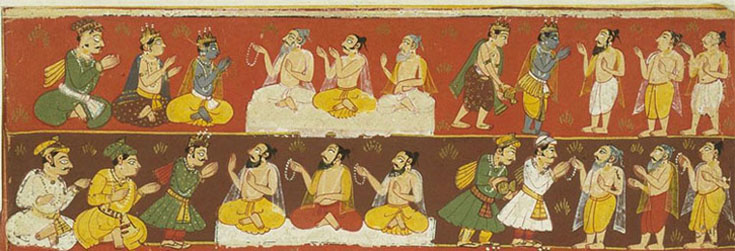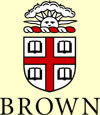- Ashok Aklujkar, “Language Philosophy in the Mahābhārata” (abstract)
- Greg Bailey, “On the distribution, use and meaning of the dhātu √vṛt in the Mokṣadharmaparvan” (abstract) (statistical report)
- John Brockington, “The Jāpakopākhyāna (MBh 12.189-93) or ‘Japa – old or new?’” (abstract) (paper)
- Johannes Bronkhorst, “The Mahābhārata and the Revival of Brahmanism” (abstract)
- André Couture, “Sāṃkhya and Yoga : Some Missing Links” (abstract) (draft of paper)
- James L. Fitzgerald, “Slaying the Dragon of ‘Sāṃkhya’ in the Mahābhārata” (abstract) (draft of paper)
- Alf Hiltebeitel, “Mokṣa and Dharma in the Mokṣadharma” (abstract)(draft of paper)
- Angelika Malinar,“Transition to Philosophy or Philosophy in Transition? Contex-tualizing Philosophical and Theological Doctrines in the Mahābhārata.” (abstract)
- Peter Scharf, “Advaita Sāṅkhya in the Mahābhārata” (abstract)
- Peter Schreiner, “The Status of karman as a ‘theory’ in the Śāntiparvan of the Mahābhārata” (abstract) (draft of paper) (appendix to paper)
- Fred Smith, “Non-Sāṃkhya Constructions of the Person and Body in the Mahābhārata” (abstract)(draft of paper)
The abstracts of Bronkhorst, Fitzgerald, and Malinar are too large for this listing. The links next to their titles will bring you to separate .pdf versions of their abstracts.
This paper will explore, in particular, the notions of four levels of vāc, pratibhā and mahān ātman that appear in the writings of the grammarian-philosopher Bhartṛhari and in parts of the Mahābhārata. It will then point out the implications of the exploration for understanding the process through which analytical philosophical parts of the Mahābhārata could have come into being.
«»«»«»«»«»«»«»«»«»«»«»«»«»«»«»«»
Given the importance of pravṛtti and nivṛtti as shaping ideologies in the MBh and a host of other Indic texts, a study of the occurrence of the uses of √vṛt in the widest possible sense is a desideratum for an understanding of both the MBh and the MDh. In the present contribution I present statistical concentrations of occurrences of √vṛt in particular passages, and I discuss if these are associated with the communication of specific doctrines. In a selection of these chapters I will compare their occurrence and use with other verbs and nouns denoting ‘being’ and ‘movement.’ Time permitting, I will draw some comparisons with √vatt/vṛt as it is used in some early Buddhist texts.
«»«»«»«»«»«»«»«»«»«»«»«»«»«»«»«»
In my paper I shall be examining the Jāpakopākhyāna (MBh 12.189-93), a text which seems in some ways “out on a limb” in the Mokṣadharmaparvan, as well as surveying the occurrence of japa and its cognates throughout the Mahābhārata, in order to provide some further background and also to probe its meaning. I also look at some other terms found in the passage and comment on their distribution elsewhere. as part of the attempt to position the passage. I seek to unravel the textual history of the passage and the logic of combining its parts, as well as the message that it conveys. I suggest that the prominence of Brahmā in the passage may form one key to its interpretation, while the fact that the next highest (though much lower) frequency of japa and related terms is in the NārāyaṇIya seems to offer another clue, especially in conjunction with the significance of japa in the developed Pāñcarātra system.
As an appendix to my paper, I will add a listing of all occurrences of √jap etc. in both epics.
«»«»«»«»«»«»«»«»«»«»«»«»«»«»«»«»
Discussion of sāṃkhya and yoga usually adopts either a philosophical point of view or an historical (and philological) approach. Indeed, it is very useful to reflect on the evolution of the terminology used and to highlight the development of notions that ended up in the Sāṃkhyakārikās and the Yogasūtras as we now know them. There is at least some indication that these notions might be rooted in Vedic ritual. The stories invented to legitimize these rituals and the various speculations that such activities generate tend to indicate that it is not enough to harness oneself to a specific task; it is just as important, if not more so, to be enlightened by an appropriate discrimination or discernment. I will try to show that, before separate and complementary developments saw the light of day, at least some Brahmins held to the idea that the attitude needed for the correct performance of all rituals is a sustained effort steered by a sound judgment. In this paper, I come at this question from three different directions, but always with a similar train of thought: I begin with a consideration of Kapila’s action in the Sagara episode and an analysis of a short scene in the Nala episode, move on to the double presence of a yogācārya and a sāṃkhyācārya in certain cosmogonies, and finish with remarks on the significance of the double emphasis on kratu and dakṣa in the Vedic context. I am in fact convinced that these apparently disconnected themes point in a single direction and directly impact the way in which the relationships between sāṃkhya and yoga came to be construed in the Epic and Purāṇic texts.
«»«»«»«»«»«»«»«»«»«»«»«»«»«»«»«»
As Patrick Olivelle observes in his Introduction to the Buddhacarita, Aśvaghoṣa uses the term mokṣa at Buddhacarita 5.17 “in the technical meaning given to it by Manu, namely, renunciatory asceticism of a wandering mendicant . . . rather than simply liberation from the cycle of rebirth” (2008, xxi-xxii). As I have shown in my own study of the Buddhacarita, Aśvaghoṣa relates usages of mokṣadharma, and thus implicitly mokṣa, more to the Mahābhārata than to Manu. I will explore this point for the degree to which it might apply to usages of mokṣa and mokṣadharma in the Śāntiparvan, doing so with particular reference to the Śāntiparvan’s last three units: the Śuka story, the Nārāyaṇīya, and the Uñcavṛttyupākhyāna. Is it possible to use Olivelle’s point to interpret the “arc” of Bhīṣṃa’s instructions to Yudhiṣṭhira as they swing from mokṣadharma to dānadharma?
«»«»«»«»«»«»«»«»«»«»«»«»«»«»«»«»
Classical Sāṅkhya, the Sāṅkhya of Īśvarakṛṣṇa, is characterized by a fundamental dualism. Individual selves (puruṣa) are materially distinct from original nature (prakṛti). In classical Yoga too, which adopts the ontology of Sāṅkhya almost entirely, it is explicitly denied that an individual self is subtler than and is the material cause of prakṛti. Instead puruṣa is asserted to be an efficient cause (hetu) of the manifestation of prakṛti. In the Mahābhārata, however, the characteristic of being subtler than and being the material cause of prakṛti is ubiquitously affirmed. Such an affirmation abandons dualism and places epic Sāṅkhya in a traditionally Advaita Vedānta camp. Therefore, despite Śaṅkara's radical opposition to dualism, pre-Śaṅkara Sāṅkhya appears to be quite close to early monism.
«»«»«»«»«»«»«»«»«»«»«»«»«»«»«»«»
My question is what makes the karman theory a "theory" (rather than, for example, a "belief" or a "doctrine"). I assume that a theory serves to give an explanation to a problem or explains a situation that calls for explanation. I assume further that it should be possible to deduce from the formulation(s) of the theory the underlying problem or question(s).
At least I want to try to do so. The context is that of exploring "philosophy" in the MBh: if statements about karman form a theory, is the karman theory philosophical, are the questions to which it answers philosophical? How to distinguish occurrences of karman "theory" from other occurrences (contexts) and other theories? The background is the fact that "the theory of rebirth and karmic retribution" has been proposed as a defining characteristic of Indian culture (in fact, since when is that so?) or, more specifically and in historical perspective, of the culture of Greater Magadha. This requires to read history backwards for identifying and differentiating the elements of the theory. What can be deduced about the cultural function and context of the theory? And -- most centrally -- what does the karman theory as a cornerstone of culture add to our understanding of the MBh, of its culture and of the role of philosophy ("theory") in this culture? The application of such considerations to selected text passages will have to provide "the proof of the pudding", but at the time of writing this I cannot yet finalize the selection and cannot anticipate how much pudding will be left "for the eating".
«»«»«»«»«»«»«»«»«»«»«»«»«»«»«»«»
It is generally acknowledged that among the most intimate aspects of the Mahābhārata, of ayurvedic literature, and, later, of the Purāṇas is the fundamental place in them of Sāṃkhya. Whether this was original to these texts (presuming that we can realistically reconstruct what was original) or whether much of this Sāṃkhya was palimpsested to earlier versions is somewhat germane to our story. Regardless, however, of whether we can conclusively reconstruct such textual and ideological layerings, we can still locate in the MBh clear notions of persons and bodies conceived along very different lines. This is what I shall attempt to do here. First, I shall discuss a few passages in which Sāṃkhya is insufficient to explain mental and material substantiality in the MBh (and elsewhere, esp, in ayurvedic texts). I shall further draw from passages in the MBh, including from the Anugītā (MBh 14.16-50), to show that certain notions that are often regarded as insubstantial, including of prāṇa, puruṣa, and ātman are in fact substantial, and not only fit uncomfortably into Sāṃkhya evolutionary explanations, but can be and are explained adequately elsewhere. Not only can these comparatively insubstantial notions be firmed up, but the more abstract “person” and the more concrete “body” can also be understood with little reference to Sāṃkhya. In short, in this presentation I’ll examine the relationship between person and body, then show how the MBh and related literature constructs them differently, both within and without the Sāṃkhya paradigm.


